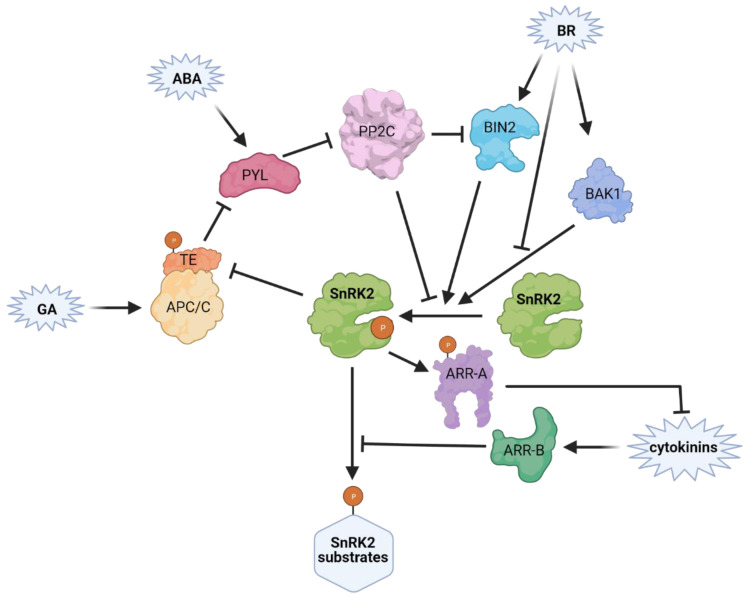Figure 5.
Plant hormones in SnRK2 regulation. Lines with arrowheads indicate positive regulation, bar-ended lines indicate inhibition. SnRK2 activity is impacted by abscisic acid (ABA), brassinosteroid (BR), giberellin (GA) and cytokinin signalling pathways and crosstalk between those hormones. BRASSINOSTEROID INSENSITIVE 2 kinase (BIN2), a negative regulator of BRs signaling, phosphotylates SnRK2.2 and 2.3 and enhances their activity. In the absence of ABA, group 3 SnRK2s and BIN2 are inhibited by clade A type 2C protein phosphatases (PP2Cs). In the presence of ABA, the hormone binds to PYRABACTIN RESISTANCE 1/PYR1-LIKE/REGULATORY COMPONENTS OF ABA RECEPTOR (PYLs) which interact with and inhibit PP2Cs. BR co-receptor BRASSINOSTEROID INSENSITIVE1-ASSOCIATED RECEPTOR KINASE 1 (BAK1) through SnRK2.6 phosphorylation induces ABA-dependent stomatal closure, whereas BRs negatively regulate BAK1/SnRK2.6 complex formation. Positive regulators of cytokinin signaling, Type-B Arabidopsis response regulators (ARRs; namely ARR1, ARR11, and ARR12) interact with and inhibit SnRK2.6 activity. On the other hand, a negative regulator of cytokinin signalling, Type-A ARR (ARR5), is stabilized through phosphorylation catalysed by SnRK2s. The link between GA and ABA pathways relies on interaction of an activator of the E3 ubiquitin ligase complex APC/CTE—Tiller Enhancer (TE) with PYL. GA enhances the interaction, which leads to PYL degradation and reduction of the activity and protein level of group 3 SnRK2s. The presence of ABA induces TE phosphorylation by SnRK2s from group 3 and PYL dissociation from TE-PYL complex, thus preventing the GA-induced degradation.

